Abstract
Although photovoltaic (PV) solar cells have been widely used for a variety of applications, several critical issues are yet to be addressed, including further enhanced power conversion efficiency (PCE) and their 2D solar harvesting with limited land availability. It has been reported that traditional PV installations require approximately 22,000 square miles to power the entire United States—posing a significant barrier, particularly in urban and agricultural settings. A unique dual modality of PV system has been proposed and implemented for both power generation and crop photosynthesis, namely, agrivoltaics. This system installs PV panels over the crops while harvesting solar for PV electricity generation and, at the same time, integrates with crop cultivation, which is a promising solution to optimize land utilization. However, for opaque PV panels, sunlight is often obstructed, potentially impacting plant growth and yield. To address this critical issue, a 3D solar harvesting concept has been proposed and experimentally investigated. By placing multiple layers of transparent PV panels parallel, sunlight can penetrate multiple layers and generate electricity on each PV, significantly enhancing the solar harvesting surface area. Most importantly, sunlight can also be collected by the crops underneath for effective photosynthesis. Among various PV materials, dye-sensitized solar cells (DSSCs) using porphyrin-based dyes have demonstrated potential for spectral modulation, optimizing both electricity generation and crop illumination. This review focuses on a novel approach to a 3D solar harvesting system via a multi-layered PV architecture for agrivoltaics. Also discussed are the current challenges in agrivoltaics, spectral selective mechanisms, and 3D solar harvesting architecture that show promise for sustainable energy production and land-efficient solar power deployment.
Keywords:
agrivoltaics; 3D solar harvesting; transparent PV; spectral selectivity; yield; hybrid; multilayer 1. Introduction
1.1. Three-Dimensional Solar Harvesting via Multiple Transparent Photovoltaic Solar Cells: A New Concept
One of the key parameters of PV solar cells is the power conversion efficiencies (PCEs) ranging between 10% and 30% [1,2,3,4,5,6,7,8,9,10,11] for current PV technologies. Among all PV technologies, organic photovoltaics (OPVs) offer several advantages over traditional silicon solar panels, including the potential for low-cost, transparency, flexible, and lightweight manufacturing, with their highest reported PCE remaining around 15%, as documented by the National Renewable Energy Laboratory (NREL) [12,13,14,15]. However, the PCEs of OPVs are generally lower than those of silicon-based solar cells. In recent years, perovskite solar cells have emerged with remarkable progress, surpassing 25% efficiency in laboratory settings [16,17,18,19]. Perovskite solar cells offer advantages like high efficiency, low cost, ease of fabrication, and a tunable band gap, making them attractive for various applications. In addition to these PV technologies, dye-sensitized solar cells (DSSCs) have achieved efficiencies between 10% and 15% [20,21,22]. DSSCs are known for their low production costs, ease of fabrication on flexible substrates, potential for transparency and colorization, and good performance under low or diffuse light conditions. DSSCs have been applied in so-called Building-Integrated Photovoltaics (BIPVs) for the architectural design of energy-efficient windows and façades. Other novel PVs, such as polymer photovoltaics (PPVs), have diverse applications in flexible electronics, exhibiting the potential to transform renewable energy technologies. However, their PCEs are in the range of 10% to 15% [23,24,25,26,27,28,29,30], requiring further improvements.
One common characteristic of PV application is solar harvesting in 2D dimensions due to the architecture of the solar panels. This unique dimensional feature of PV requires a significant land surface area for collective solar harvesting. Roughly 22,000 square miles of solar panel-filled land (about the size of Lake Michigan) would be required to power the entire United States of America, according to a report from the National Renewable Energy Laboratory [6]. This includes more than 140 million households and businesses, based on 13–14% efficiency for solar modules [6]. However, the availability of suitable land for solar installations is becoming increasingly limited, especially in large modern cities. Even having large PV farms in deserts and forests poses considerable environmental concerns. On the other hand, having PV farms far away from the cities, both electricity storage and transmission are also major concerns to widespread solar energy adoption for innovative solutions in both urban environments and agricultural settings.
Among all PV applications, agriculture photovoltaics (agrivoltaics) presents a promising strategy for maximizing land for both the benefits of crop cultivation and solar power generation [26,27,28]. By placing solar panels over agricultural fields, light distribution is optimized to support both electricity production and photosynthesis. In this way, agrivoltaics can simultaneously address two critical global challenges: food security and renewable energy production. If designed correctly, farmers can generate solar power with PV panels in farm fields while cultivating crops on the same land. This dual-modality PV system can achieve utilization of land productivity in terms of crop yield and power generation through expanded renewable energy infrastructure. Other benefits of agrivoltaics include increased crop yields, reduced water consumption, and improved soil health. It also offers farmers a new source of income while encouraging sustainable land use. By helping agriculture adapt to climate challenges, agrivoltaics can boost rural economies and support global sustainability efforts.
Traditional non-transparent photovoltaic systems often obstruct a considerable portion of sunlight (Figure 1a), reducing its availability for plant growth. To overcome this limitation in agrivoltaic applications, researchers have explored the development of transparent PV systems arranged in a three-dimensional (3D) configuration using stacked PV panels for enhanced solar harvesting and power generation [29], as shown in Figure 1b. In this design, multiple transparent solar panels are arranged in parallel, allowing for solar harvesting along the z-axis in addition to the conventional x-y plane. This strategy, denoted as “3D-Solar”, maximizes the solar collection area by integrating multiple panels within a limited surface area. By achieving an average visible transmittance (AVT) of 70–80%, sufficient light penetration through multiple panels supports both electricity generation and agricultural productivity [29]. As a result, each panel in the 3D-Solar system contributes to overall energy output, leading to a net increase in power generation. The shift from a two-dimensional to a three-dimensional solar harvesting structure enhances energy density within a confined space, improving power conversion efficiency (PCE). Preliminary experimental data on this innovative 3D-Solar harvesting approach have demonstrated encouraging outcomes, further supporting its feasibility and effectiveness [29].
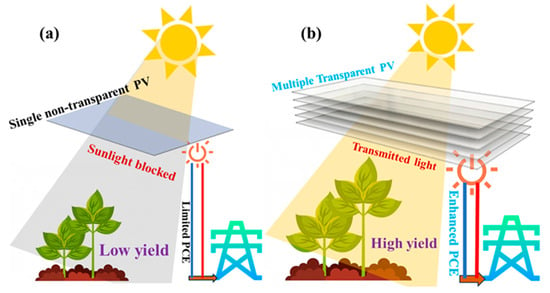
Figure 1.
Schematic diagram showing (a) the conventional single non-transparent PV blocking sunlight and reducing yield, and (b) 3D-Solar with multiple transparent PVs for enhanced yield and PCE [29].
In agrivoltaics, balancing energy generation with optimal light transmission for plant growth presents a fundamental challenge in the integration of photovoltaic (PV) technology into solar harvesting systems. In this review, we focus on a materials science approach to addressing the critical issues of PV transparency and spectral selectivity. Specifically, we explore the previously published experimental results in the development of multi-panel 3D-Solar systems, which leverage high-transparency PV materials to maximize light penetration while enhancing energy conversion efficiency. On the other hand, we discuss the possibility of spectral selectivity via the development of novel hybrid materials designed to transmit photosynthetically active radiation (PAR), ensuring that critical wavelengths required for plant photosynthesis are preserved while non-essential wavelengths (UV/IR) are harnessed for energy generation. Developing these advanced functional PV materials will establish a foundation for next-generation agrivoltaic technologies that optimize both agricultural productivity and solar energy harvesting.
1.2. 3D-Solar Applications in Agrivoltaics
Non-transparent silicon-based PV panels are not ideal for agrivoltaics since they block sunlight, as depicted in Figure 2. As shown in this figure, although silicon PVs exhibit the highest PCE, the fully opaque nature blocks a significant amount of sunlight from reaching crops underneath. Due to less light for photosynthesis, crop yields are adversely affected, which is a major challenge in agrivoltaics. Low transparency of organic photovoltaics (OPV) may allow partial light through; however, this is not sufficient for effective photosynthesis. For an optimized dual-modality PV system, a high average visible transmittance (AVT) of over 70% is needed for 3D-Solar harvesting. Most OPVs only reach 30–50% AVT, which is quite low for crop yield, therefore limiting their role in agrivoltaics. To address this challenge in agrivoltaics, novel PV technologies with both high AVT and PCE are required. As shown in Figure 1b, the 3D-solar harvesting system (3D-Solar) can be designed and developed with transparent multi-panel PVs (Figure 1b). By optimizing light transmission through multiple transparent PVs, it is possible to achieve efficient solar harvesting for both power generation and crop cultivation. The 3D-Solar system will revolutionize the integration of solar energy generation with agricultural practices, paving the way toward sustainable and efficient food and energy production systems.
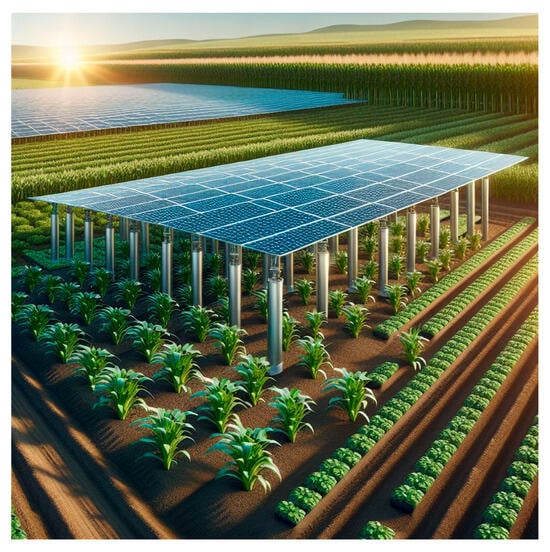
Figure 2.
Schematic illustrating agrivoltaics. The non-transparent PV solar panels block sunlight.
1.3. Enabling Ideas
The efficiency of photosynthesis strongly depends on the light wavelength. Studies [30] show that photosynthetically active radiation (PAR) exists in the 400–700 nm range (Figure 3), which is the most effective spectral region for driving photosynthesis. Light below 400 nm or beyond near-infrared (NIR) 700 nm is much less effective due to the lower quantum yield of CO₂ assimilation when applied as a single waveband (Figure 3a). Red light (600–700 nm) exhibits the highest quantum yield, which is the most efficient for photosynthesis. Blue light (400–500 nm) is also very effective, with strong absorption by green leaves. As can be seen in Figure 3a, the percent quantum yield (PQY) of green light (500–600 nm) is slightly lower than that of blue light, attributable to its lower absorptance by plant leaves. Green light is the least absorbed but mostly reflected, which is responsible for leaves’ characteristic green appearance. Based on these absorption characteristics, solar panels can be designed to selectively transmit or filter light, maximizing energy generation and enhancing plant growth.
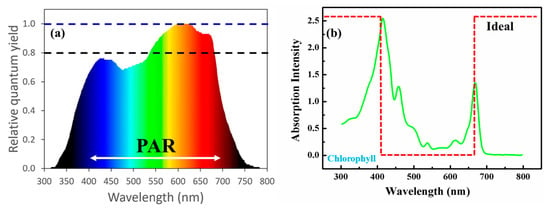
Figure 3.
(a) The maximum quantum yield for narrow wavebands of light from ultra-violet to far-red wavelengths [30]; (b) absorption spectrum of chlorophyll with deashed line of ideal absorption [31].
1.4. Spectral Tunable Photovoltaics (PVs)
A nature-inspired method has been developed to synthesize eco-friendly porphyrin compounds known for absorbing UV and NIR light [31,32,33,34,35,36]. Porphyrins, such as chlorophyll, chlorophyllin, pheophorbide, and phthalocyanine, can function as light-sensitive materials in dye-sensitized solar cells (DSSCs) [20,21,22]. Figure 3b shows chlorophyll’s unique spectrum, with strong absorption peaks in the UV and NIR regions but minimum in the visible range [31]. The dotted line in Figure 3b outlines the ideal absorption characteristics from UV to NIR. As shown in this figure, the minimal PV absorption in the visible range results in light transmission between 400 nm and 700 nm for effective photosynthesis. Meanwhile, strong PV absorptions below 400 nm and above 700 nm enable photon conversions for high power generation. Our previous research [31] has led to a porphyrin hybrid that can be spectrally tuned to approach this ideal spectrum through structural and compositional manipulations. The spectra shown in Figure 3 provide an underlying mechanism for the design of 3D-Solar, i.e., while achieving the highest PV transparency for efficient plant photosynthesis, each PV in the 3D-Solar system can generate electricity for enhanced system PCE. It should be noted that the PCE of each PV may not be substantially high; the synergistic power generation with multiple PVs can result in a much greater overall system PCE (Figure 1b) [29].
According to Figure 3b, photons below 400 nm and above 700 nm should be primarily absorbed for photovoltaic electricity generation. Meanwhile, moderate light levels help plants grow without overwhelming them. Therefore, controlling the amount of light passing through the PVs in the designated wavelength range can maximize solar energy conversion while enhancing crop yield. By fine-tuning the transmitted light, water use can also be reduced by limiting extra evaporation for maintaining soil moisture. Based on these considerations, spectral selective tuning is the key to PV design and hybrid synthesis. The following aspects are critical in the design and development of spectral selective PV panels:
Adequate Photosynthesis with Enhanced Solar Collection: Regular solid PV systems often block sunlight, which cuts down on how much plants underneath can photosynthesize. Transparent PVs allow spectral selected light to partially pass through for both power generation and photosynthesis. However, the spectral selectivity of the transparent PV must be controlled and optimized for partitioning the right amount of sunlight in the designated wavelength range for efficient photovoltaic electricity generation and optimum photosynthesis of the plants.
Solar Harvesting via Multi-Layer Transparent PVs: To increase the solar harvesting surface area, multiple transparent PV panels can be structured in parallel for collective power generation. Meanwhile, portions of sunlight can pass through the multiple PV panels, reaching plants underneath for optimum photosynthesis. This way, not only can the PCE of the multi-layer PV system be enhanced, but the sunlight is also spectral selectively optimized for photosynthesis.
Reduced Water Consumption for Improved Soil Conditions: The regulation of light transmission by spectral selective transparent PVs can mitigate excessive evaporation, conserving vital water resources. Additionally, moisture can be reserved well via controlled sunlight reaching the soil. The 3D-Solar system is a multi-faceted agrivoltaics system with a series of parameters, including the PV panel architecture, number of panels, transparency, and incident sunlight angle, which all contribute to sustainable water management practices while enhancing overall soil quality.
The key in the design of 3D-Solar deals with the balance between system PCE and crop yield. If designed correctly, it will offer a comprehensive solution to address critical challenges such as optimizing photosynthesis, increasing energy conversion efficiency, and fostering sustainable water management practices.
1.5. Transparent Organic Photovoltaics (TOPVs)
In agrivoltaics, as described above, high AVT is critical for PV solar light harvesting and transmitting. Among all PV systems, transparent organic photovoltaics (TOPVs) are ideal due to their lightweight nature, low cost, flexibility, and appreciable AVT. TOPVs have been applied in architectural structures such as smart building skins [37,38,39,40,41,42]. However, TOPVs suffer from their lower PCE compared to silicon-based photovoltaics. Advanced TOPVs have been shown to exhibit PCE up to 12% [43]. Yang et al. reported a typical TOPV with a transparent active layer and electrodes [44,45]. The active layer consists of the NIR light-sensitive photovoltaic polymer PBDTT-DPP as the electron donor and PCBM as the electron acceptor. This device achieves a PCE of 4.0% with an average visible transmittance (AVT) of 61.0% [44,45]. They found that while PBDTT-DPP primarily absorbs in the NIR region, the combination of PBDTT-DPP and PCBM results in a broader absorption spectrum, leading to an overall reduction in AVT [44,45].
1.6. Transparent Porphyrin-Based Dye-Sensitized Solar Cells (DSSCs)
Among various spectrally selective materials, the current–voltage (I-V) characteristics of chlorophyll have been explored for photovoltaic (PV) applications [46]. Setyawati et al. showed significant PV currents and voltages generated by solar light in several dye-sensitized solar cells (DSSC), including those utilizing chlorophyll and TiO2 [46]. They found that chlorophyll exhibited a higher current output than TiO2, attributed to its enhanced dye-sensitizing ability. A similar effect was observed wherein chlorophyll produced greater light-induced voltages. The incorporation of Fe(III) in chlorophyll was expected to further enhance light absorption in both the UV and NIR regions [31,35]. Notably, the chlorophyllin compound demonstrates considerable stability, maintaining steady current and voltage outputs over 14 days. Given these I-V characteristics of porphyrin-based compounds, there is strong potential for developing transparent PV thin films for multilayer designs, as depicted in Figure 1b. UV and NIR absorption properties can be finely tuned by hybrids between porphyrins and iron oxides [31]. In contrast to transparent organic photovoltaics (TOPVs), solar harvesting can be spectrally optimized for 3D solar harvesting, enabling a broad range of applications.
Based on the unique absorption characteristics of the porphyrin compounds, we developed various solar harvesting thin films with high AVTs approaching 85% [47,48,49,50,51,52,53]. The solar absorption spectra were tuned with hybrids between porphyrins and Fe3O4@Cu2-xS [31]. It was found that AVTs are mainly affected by the film thickness, which can be controlled by the spin coating process. As described earlier, the key is to pass the majority of light through PVs between 400 nm and 700 nm for crop yield due to high PAR in this wavelength range. As shown in Figure 3b, both chlorophyll and chlorophyllin exhibit strong UV and NIR absorptions but low absorptions in the visible range. This kind of absorption is ideal for 3D-Solar design. Fundamentally, the design of PVs is based on the underlying conditions of the light absorption spectrum, visible transmittance, and PV efficiencies. Research will need to focus on systematic investigations on hybrid spectral tunability, chemical synthesis, structure development, optical characterization, and architecture of the 3D-Solar system.
1.7. Transparent Porphyrin Thin Films
“Porphyrin rings” commonly refer to four modified subunits linked by carbon atoms to form a distinctive “ring-like” configuration. A class of heterocyclic macrocyclic organic compounds shares this structural motif, known as porphyrin (Figure 4) [52]. Each porphyrin contains 26 π-electrons, with 18 of them forming a continuous cycle of conjugated bonds, as illustrated in Figure 4a–d [52]. Typical porphyrin compounds include chlorophyll, chlorophyllin, hemoglobin, and phthalocyanine. These compounds are well known for their unique and intrinsic photon absorption spectra, as shown in Figure 4. The specific absorption spectrum of each porphyrin derivative is determined by the metal ion coordinated to its four nitrogen atoms. For example, chlorophyll (Chl), which features a magnesium center, exhibits a characteristic saddle-shaped absorption profile with peaks in the UV and NIR regions (Figure 4a). Substituting the magnesium center with a copper atom results in chlorophyllin (Chlin) (Figure 4b), which retains two primary absorption peaks at 415 nm and 664 nm. Other notable porphyrin-based compounds include hemoglobin (HB) (Figure 4c) and phthalocyanine (Phth) (Figure 4d), each displaying distinct absorption characteristics.
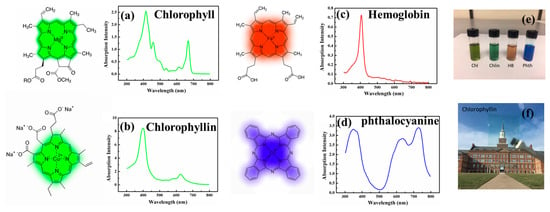
Figure 4.
(a) Chlorophyll structure and absorption; (b) chlorophyllin structure and absorption, (c) hemoglobin and absorption, (d) phthalocyanine and absorption, (e) solutions of these porphyrin compounds, and (f) a photograph of chlorophyllin thin film in front of campus buildings, showing their high transparencies (AVT = 85%) [52].
We synthesized highly transparent porphyrin films via solution techniques. Figure 4e shows a photograph of the solutions of the porphyrin compounds synthesized in our labs [47,48,49,50,51,52,53]. Figure 4f shows the photograph of chlorophyllin thin film in front of campus buildings, indicating its high transparency (AVT = 85%). These thin films were deposited on glass substrates via spin coating. The thickness is in the range of 300–450 nm, depending on the processing [52].
1.8. Solar Harvesting Through Multiple Semitransparent Cadmium Telluride Photovoltaic Module
As shown in Figure 1b, solar panels can be arranged in parallel, significantly enlarging the solar light harvesting area [29]. In this fashion, all solar panels can generate electricity under the limited surface area only from the top solar panel, enabling solar harvesting vertically for enhanced overall energy generation. In our previous study [29], we carried out I-V curve measurements on five commercial CdTe solar panels with different average visible transmittances (AVT): 40%, 50%, 60%, 70%, and 80%. These CdTe solar panels were arranged in parallel (Figure 2) with descending and ascending transparency to determine their I-V characteristics, including maximum output power and PCE. Five commercial CdTe solar panels (Solar First Technology Co., Tempe, AZ, USA) with 150 × 150 mm2 dimensions were used in this study for I-V measurements. These five solar panels have different average visible transmittances (AVT): 80%, 70%, 60%, 50%, and 40%, respectively.
As shown in Figure 5a, the 80% AVT is virtually quite transparent. In this experiment, we laid five CdTe in parallel, as shown in Figure 5b,c, with different orders of AVT values. In Figure 5b, the top one is AVT 80, which ensures the receiving and passing of most solar light from the top (descending order). However, as expected, the low AVT PV, in fact, exhibits the highest PCE. Therefore, we also arranged them in ascending order (Figure 5c). Figure 5d shows the actual PV experiments with the stack of CdTe PV panels.
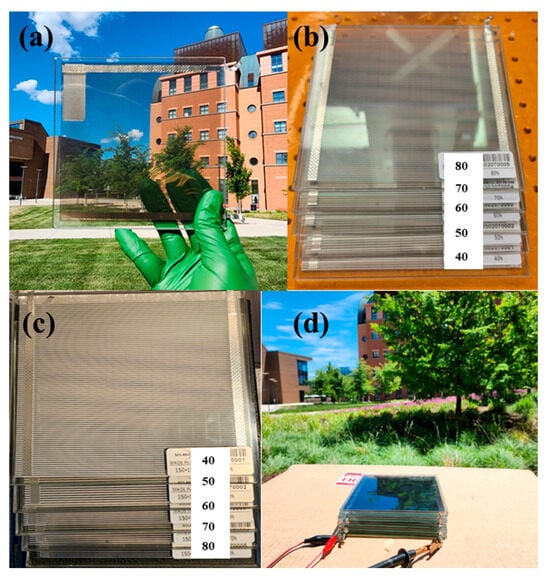
Figure 5.
Photographs of (a) 80% CdTe solar panels on campus; (b) five CdTe solar panels stacked in parallel with descending transparency: 80%, 70%, 60%, 50%, and 40%; (c) five CdTe solar panels stacked in parallel with ascending transparency: 40%, 50%, 60%, 70%, and 80%; (d) I-V measurement set for five CdTe solar panels stacked in parallel [29].
The light power density (LPD) on each PV surface was measured for both descending and ascending orders, and their values are summarized in Table 1. In the descending configuration, where the most transparent panel is positioned at the top, the LPD begins at 55.4 mW/cm2. It remains substantial at 44.32 mW/cm2 on the second panel but decreases progressively to 31.024 mW/cm2 and 18.614 mW/cm2 on the third and fourth layers, respectively. Even at the bottom (fifth) panel, the LPD is still measurable at 9.307 mW/cm2. These data confirm that natural sunlight penetrates through all layers, ensuring that each panel contributes to electricity generation. In the ascending configuration, with the least transparent (40%) panel placed on top, the LPD diminishes more rapidly. However, sufficient light is transmitted to the panels underneath, allowing them to continue generating electricity at multiple levels.

Table 1.
Light power densities of parallel CdTe solar panels in descending and ascending orders [29].
The I-V curves of the stacked panels in both descending and ascending orders were also measured, as shown in Figure 6. Since some of the CdTe solar panels are only semi-transparent, significant light attenuation occurs as light passes through successive layers. As shown in Figure 6a, the I-V characteristics align with the measured light power densities for each solar panel. In the descending configuration, where the most transparent panel is on top (55.4 mW/cm2), the short-circuit current (Isc) gradually decreases through the subsequent layers. Despite this reduction, all panels maintain appreciable current levels. Similarly, in the ascending configuration (Figure 6b), where the least transparent (40%) panel is positioned at the top, the I-V curves again correspond to the light power densities. The top panel exhibits the highest power conversion efficiency (PCE), but due to its low transparency, the Isc values of the underlying panels drop significantly, as detailed in Table 2. Consequently, the maximum power output (Pmax) of the lower panels is also markedly reduced, consistent with the declining light power densities shown in Table 1.
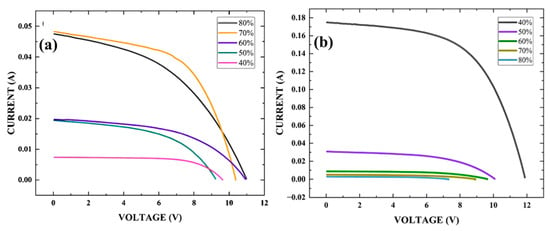
Figure 6.
I-V curves of CdTe solar panels that are arranged in (a) descending order and (b) ascending order [29].

Table 2.
The I-V curve parameters of multiple CdTe solar panels in descending and ascending orders [29].
As shown in Table 2, despite reduced AVT and LPD, each PV can register appreciable light and generate considerable electricity for both descending and ascending orders. For instance, in descending order, LPD decreases from 55.4 mW/cm2 (top PV) to 44.3 mW/cm2 on the second PV, to 31.024 mW/cm2 on the third PV, to 18.614 mW/cm2 on the fourth PV, and to 9.307 mW/cm2 on the fifth PV. Even for considerable LPD reduction, the maximum output power Pmax remains at an appreciable level on each PV panel, as shown in Table 2. Correspondingly, Pmax achieves 0.305 W from the top PV panel (80% AVT) but remains at 0.302 W (70% AVT) on the second PV panel, even under a reduced light intensity of 44.32 mW/cm2. This can be attributed to the greater power conversion efficiency (PCE) of the 70% panel (3.74%) compared to the 80% panel (1.94%).
Although Pmax decreases considerably on the third (60%) and fourth (50%) panels, each PV exhibits the photovoltaic effect even under reduced LPD. As shown in Table 2, in descending order, Pmax reaches 0.11 W, 0.09 W, and 0.047 W on the third, fourth, and fifth PV panels, respectively. These findings highlight the feasibility of 3D-Solar harvesting using multiple transparent and semitransparent panels, enabling significantly improved energy generation efficiency. The IV curves for the AVT ascending order are shown in Figure 6b. With the 40% panel at the top, the short-circuit current (Isc) is the highest. However, due to low AVT on the top, LPD on the PV panels underneath is significantly reduced, resulting in a large reduction in Isc, as shown in Figure 6b. These results are consistent with the decreasing light power densities presented in Table 1. Notably, the total Pmax of five solar panels arranged in ascending transparency reaches 1.440 W, which exceeds that of the descending configuration (0.786 W). This suggests that a stack of CdTe solar panels in ascending order of transparency can generate 20% more power than a single panel, further supporting the potential advantages of multi-layered solar harvesting.
The PCE data for both descending and ascending orders are shown in Table 3. As can be seen in the table, the top 40% panel exhibits the highest power conversion efficiency (PCE) of 9.60% in the ascending order configuration. However, the PCE of the underlying panels decreases significantly due to reduced LPD. We can consider the entire five-panel system for an overall system PCE that reaches 11.53% for the ascending order, representing a 20% increase. This demonstrates that stacking five solar panels can enhance the overall efficiency from 9.60% to 11.53%. In the descending order configuration, the top 80% panel achieves a PCE of only 1.89%. However, when accounting for all five panels, the system-wide PCE increases to 6.3%, marking a substantial 233% improvement through the multi-layered design. These findings highlight the effectiveness of stacked solar panel configurations in significantly enhancing overall energy conversion efficiency.

Table 3.
PCE value of each CdTe solar panel in both ascending and descending orders. The PCE values of the multiple PV system with all five solar panels are also presented in both orders [29].
1.9. Transparent Porphyrin-Based DSSC
In the structure of a dye-sensitized solar cell (DSSC) [54,55,56,57,58,59,60,61], the photoanode is made of TiO2 nanoparticles coated with a dye sensitizer (Figure 7a). The porphyrin compounds are applied in DSSC as dye sensitizers due to their unique absorption characteristics. A redox electrolyte plays a crucial role via efficient dye regeneration and minimization of charge recombination. The counter electrode facilitates the regeneration of the dye and electrolyte. Transparent conducting oxide (TCO) allows light to pass through while also acting as an electrode. Figure 7b depicts the operational mechanism of DSSC [50]. When DSSC is exposed to either sunlight or indoor LED light, electrons within the dye molecules are excited from the ground state (HOMO) to the excited state (LUMO). The excited dye molecules lose electrons (oxidation) that are subsequently injected into the conduction band of the TiO2 electrode. The electrons are transported to an external circuit and the counter electrode through the transparent conducting oxide (TCO). Through the redox electrolyte, the oxidation of I− ions produces I2, which then forms I3− in equilibrium. The I3− ions migrate toward the counter electrode, where they regain electrons and are reduced back to I−.
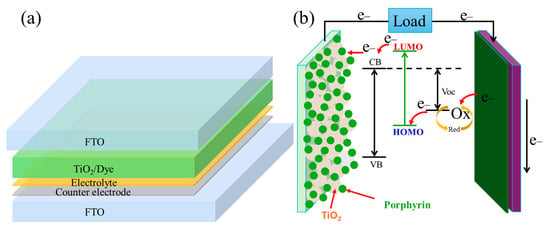
Figure 7.
(a) DSSC structure and (b) schematic working principle of DSSC [47,48,50].
1.10. Fundamental Photonic Base for Spectral Tuning of Photosensitizers
In our previous studies [47,48], we applied porphyrin as the dye sensitizer and constructed multiple semitransparent DSSC panels for 3D-Solar. The current research to focuses on spectral selectively tuning the absorption according to the requirements of photosynthetically active radiation (PAR) for both power generation via multilayers of PVs and enhanced crop yield. Researchers have explored various porphyrin-based compounds as effective photosensitizers [61,62,63,64,65,66,67,68]. The first porphyrin DSSC, employing Cu-2-α-oxymesoisochlorin, achieved a power conversion efficiency (PCE) of 2.6% in 1993 [64]. This efficiency was significantly enhanced to 12.3% in 2011 using a Zn(II)-porphyrin dye (YD2-o-C8) [69]. In 2014, a major advancement was made with the Zn-porphyrin derivative (SM371), reaching a record PCE of 13% for porphyrin-based DSSCs [70].
As shown in Figure 8, the dashed peaks (yellow dashed line) illustrate the absorption spectra of these hybrids, which can be precisely adjusted to extend into broader UV and NIR regions. The key in the design of novel hybrids is to, on the one hand, enhance sunlight transmission for crop photosynthesis. This requires photons with wavelengths between 400 nm and 700 nm to pass the multiple PVs with optimum PAR. Meanwhile, significant UV and NIR light can be absorbed by the multi-layer DSSC for photovoltaic power generation.
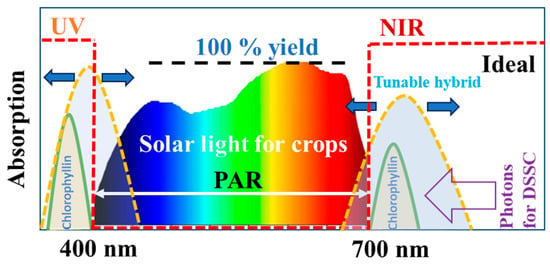
Figure 8.
The schematic diagram illustrates the spectrum partitioning strategy for both crops and DSSC. Chlorophyllin, tuned through the use of porphyrin hybrids, is optimized for enhanced solar harvesting within specific regions for DSSC while enabling the majority of visible light to pass through multiple solar panels for optimal crop growth. The desired absorption profile is indicated by the dashed red lines, depicted as a step function.
For agrivoltaics, the DSSC must be designed according to the ideal spectrum, as shown in Figure 8. Since photosynthetically active radiation (PAR) is primarily concentrated between 400 nm and 700 nm, the ideal DSSC should allow most of the light between 400 nm and 700 nm to pass the solar cells for crop photosynthesis. Therefore, the key considerations include the following: (1) the DSSC must exhibit high AVT in the visible range, ideally with high transmission between 400 nm and 700 nm. This is to ensure maximum agricultural yield; (2) to achieve high PCE, multiple DSSC panels can produce electricity collectively, as demonstrated in Table 3; (3) while passing most of the visible light to the crops below the PV system, UV and NIR light should be mostly absorbed by the hybrids (highlighted by the dashed yellow line peaks in Figure 8). These optical characteristics can be obtained via systematic investigation into hybrid design, synthesis, and characterization based on the spectra of various components. Different porphyrins with compositional variations can be developed to alter the overall absorption spectra according to the ideal condition, as depicted in Figure 8. Other compounds, such as Fe3O4@Cux-2S, can also be applied in the hybrids, since this compound exhibits broad IR absorption near 1300 nm [47,48,49,50,51,52,53]. For example, both chlorophyll and chlorophyllin exhibit minor absorption peaks in the NIR region, while Fe3O4@Cux-2S can extend abortion in much longer wavelengths. Therefore, a hybrid between chlorophyllin and Fe3O4@Cux-2S may result in more ideal absorption spectra, as shown in Figure 8. In this way, we can develop spectral tunable hybrids for ideal PV electricity generation and crop yield at the same time.
It should be noted that there are other plant types, such as C3 and C4, that may have specific responses to solar light in different wavelength regions. While C3 plants (rice and wheat) primarily rely on red and blue light for efficient photosynthesis, C4 plants, such as maize and sorghum, have a more complex light utilization mechanism that may respond differently to spectral modifications. Therefore, future research will investigate the effects of spectral selected light from 3D-Solar for other representative crops, such as tomatoes and rice. These experimental data will be valuable for refining the application of transparent PV systems in agriculture. Nonetheless, the general hypothesis remains that optimizing transmitted light spectra can support plant growth while enabling energy harvesting, making this approach a promising strategy for sustainable agrivoltaics systems.
1.11. Strategy for Tuning Optical Spectrum
For optimum optical properties, possible dye compounds need to be identified that exhibit absorption characteristics, as shown in Figure 4. In our previous research, we identified two different systems, namely, porphyrin compounds and iron oxides. Both exhibit strong UV and IR absorptions, although in different wavelength regions. The former normally absorbs light near NIR (~700 nm), while the latter absorbs light in the IR region (~1300 nm) [49]. The relationship between absorption properties and compositional variations of the hybrids will be critical in achieving the ideal optical behaviors. By controlling the ratio of these components, it is possible to fine-tune absorption spectra that match the ideal curve, as depicted in Figure 8. One approach involves using chlorophyllin as the primary component, gradually introducing other components, such as porphyrins and iron oxides, to refine the spectral profile toward the ideal absorption range. As depicted in Figure 4d, phthalocyanine demonstrates stronger absorption in the UV and NIR regions but has a narrower “optical window” compared to chlorophyllin (and chlorophyll). To achieve the desired spectral balance, incorporating controlled amounts of phthalocyanine into chlorophyllin can enhance absorption below 600 nm and around 800 nm while maintaining sufficient visible transmittance for transparency.
1.12. Development of Nano Hybrid for Ideal Absorption
Preliminary findings on porphyrin hybrid absorption behaviors are presented in Figure 9 [31]. As illustrated in this figure, varying the chlorophyllin-to-phthalocyanine ratio significantly alters the absorption characteristics of the base porphyrin. The pure chlorophyllin sample (black curve, 1:0 ratio) exhibits two primary absorption peaks near 400 nm and 650 nm. As increasing amounts of phthalocyanine are blended with chlorophyllin, NIR absorption progressively intensifies due to their structural similarities. Notably, at a 1:3 ratio (cyan curve, Figure 9), the NIR absorption reaches its highest level among the tested compositions.
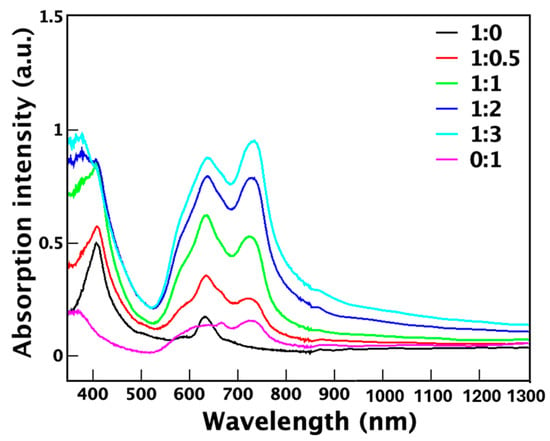
Figure 9.
Absorption spectra of chlorophyllin vs. phthalocyanine hybrids, with the ratios indicated [31].
The benefits of hybrid systems are evident, as demonstrated in Figure 9. Pure chlorophyllin exhibits only moderate NIR absorption around 620 nm. However, as the proportion of phthalocyanine increases (Figure 9), both UV and NIR absorptions are progressively enhanced while preserving the optical window necessary for transparency. The findings in Figure 9 validate the effectiveness of assembling hybrids with structurally similar yet slightly distinct porphyrins. This approach allows us to strategically select individual porphyrins as modular components and combine them to achieve optimal absorption properties.
Figure 10 presents the hybrid solutions and films, with chlorophyllin-to-phthalocyanine ratios indicated. As seen in Figure 10a, the solutions exhibit a uniform blend of both porphyrin compounds without precipitation, attributed to their structural compatibility. Additionally, the films maintain an AVT of 85%, as shown in Figure 10b. By carefully controlling film thickness and ensuring homogeneity in the hybrid solutions, even higher AVT levels can be achieved.

Figure 10.
Photographs of (a) solutions and (b) films of the hybrids, with the ratios indicated [31].
1.13. Raman Study of the Spectral Selective Hybrids
Raman scattering has been applied to study the compositional characteristics of the hybrids. In Raman scattering, the incident laser light interacts with the molecular framework, inducing vibrations in the porphyrins that are linked to the system’s phonons and electrons, leading to an energy shift in the scattered photons. When another porphyrin, such as phthalocyanine, is introduced into the chlorophyllin-based hybrid, modifications occur in the molecular vibration modes of chlorophyllin, which are reflected in the Raman spectrum. To investigate if the components are congruently joined as a hybrid, we conducted the Raman characterization on the chlorophyllin:phthalocyanine hybrids excited by a 442 nm laser. As shown in Figure 11, one of the Raman peaks is presented for hybrids of different proportions. As the composition transitions from pure chlorophyllin (1:0) to pure phthalocyanine (0:1), the peak at 1525 cm⁻1 is systematically modified. When the phthalocyanine fraction increases, this peak intensifies, as observed in the spectra for ratios of 1:1 (green), 1:2 (blue), 1:3 (cyan), and ultimately 0:1 (purple). The progressive enhancement of this Raman peak confirms a gradual structural incorporation of phthalocyanine into the chlorophyllin base solution.
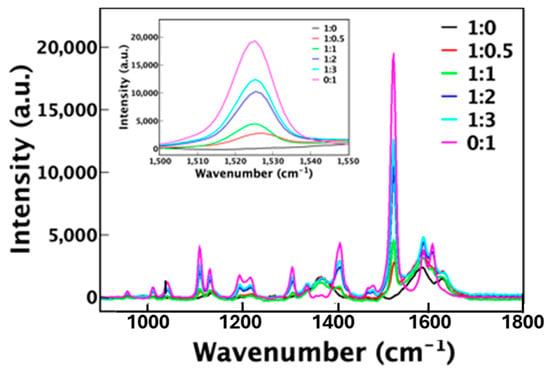
Figure 11.
Raman spectra of chlorophyllin:phthalocyanine, with the rations indicated [31].
To further refine the spectral tuning of these hybrids, in-depth Raman scattering analyses is needed to explore molecular interactions across different compositions. The primary focus is to identify the structural positioning of the secondary element within the porphyrin framework, thereby establishing a correlation between molecular structures and photonic behavior. By understanding the structural mechanisms influencing spectral tuning, as illustrated in Figure 10, the aim is to develop an effective strategy for optimizing photon conversion. This approach will guide the design of hybrids tailored for achieving an ideal solar spectrum.
1.14. Correlations Between the Hybrid Structures and Optical Absorptions
In order to investigate the optical properties of porphyrins, UV-VIS-NIR absorption spectra were obtained from the wavelength range of 300 nm to 950 nm. The absorption co-efficient () obeys the following relation at a given temperature () [71]:
where is the absorption coefficient, E is the incident energy; Eo is the onset of absorption; and Eu = ΚBT/σ is the Urbach energy, where is the steepness parameter and
is the Boltzmann constant. Urbach energy quantifies the defect density within a crystal, arising from thermal fluctuations, impurities, and structural disorder. Following the same methodology, the absorption coefficient (α) of thin films with varying porphyrin hybrid ratios can be measured and analyzed in relation to their electronic structures. The direct band gap values are determined by extrapolating the linear portion of the (Eα)2 curve to its intersection with the photon energy axis. The calculated band gap values for chlorophyll and chlorophyllin are 1.81 eV and 1.82 eV (681 nm), respectively. The bandgap energy can be progressively adjusted by incorporating a secondary porphyrin compound, such as phthalocyanine. This approach allows for precise tuning of optical absorption to reach the optimal band. Due to the hybrid nature of these porphyrin structures, their modifications introduce distinct characteristics that necessitate alternative scaling laws to accurately correlate electronic properties with optical behavior.
1.15. Design of Multiplayer 3D-Solar
The power conversion efficiency (PCE) can be improved by utilizing a multilayer solar harvesting approach, as illustrated in Figure 12 [29,47,48]. In this configuration, solar light passes through multiple transparent photovoltaic (PV) films within a confined three-dimensional (3D) space, generating electricity on each PV panel. By ensuring transparency across all PV panels, the effective surface area exposed to sunlight increases within a given volume. Consequently, the multilayer structure in Figure 12 serves as a solution to the inherently low PCE of organic photovoltaics (OPVs). This strategy effectively shifts the PCE evaluation from a conventional two-dimensional (2D) single-layer framework to a 3D solar architecture. Building upon the multilayer PV film approach outlined in Figure 5, it is possible to integrate transparent dye-sensitized solar cells (DSSCs) within the 3D-Solar framework depicted in Figure 12. Our primary focus will be on utilizing transparent porphyrin compounds, such as chlorophyllin, to develop DSSCs with enhanced optical and energy-harvesting properties.

Figure 12.
Schematic of 3D-Solar system with transparent PVs [47,48].
As described above, a DSSC can be constructed with a transparent conductive oxide (TCO) glass substrate, a photoanode, dye molecules, an electrolyte, and a counter electrode [47,48]. While the architecture of DSSC follows the conventional design, the photosensitizer dye can be composed of novel hybrids with spectral selective optical properties. In this way, the hybrids serve as photosensitizers, with designated absorptions based on the ideal condition depicted in Figure 8. To develop a 3D Solar system with DSSC, high AVT can be achieved with the patterned grids or stripes, as shown in Figure 13. The DSSC is separated by narrow transparent strips, allowing light to pass through them to enhance crop growth. A similar strategy has been effectively employed in fabricating transparent CdTe solar panels. The transparency of CdTe solar panels can be adjusted by controlling the number of solar cells per panel (Figure 13a). The CdTe solar cells are deposited onto a transparent conductive substrate, followed by photolithographic patterning to create grid-like regions with varying cell densities. Areas with a higher concentration of cells exhibit reduced transparency due to increased coverage (Figure 13b).

Figure 13.
(a) Photograph of a semitransparent CdTe panel with 144 cells; (b) a photograph of CdTe panel with 80% AVT; (c) schematic of DSSC with patterned grids.
Using the Patterned Grids Method (PGM), the DSSC is deposited onto a substrate material. The first step is to design the desired grid pattern for the DSSC. This pattern will determine the distribution and density of the solar cells across the panel’s surface. A photoresist mask is applied to the surface of the DSSC. This mask is designed to expose specific areas of the panel according to the grid pattern. The masked panel is then subjected to an etching process, which removes the DSSC from the exposed areas. In this way, a grid pattern on the panel’s surface can be developed (Figure 13c). Semitransparent DSSCs can be developed by controlling the grid pattern and the density of cells within the pattern. AVT up to 80% can be achieved for the multiple PV system, achieving both crop growth and solar energy generation.
1.16. Preliminary Experiments on a 3D-Solar with DSSCs
We initiated preliminary data collection on the 3D-Solar harvesting system by configuring five photovoltaic (PV) units in a parallel arrangement, as illustrated in Figure 12 [29]. Among the various dyes used in dye-sensitized solar cells (DSSCs), N719 is a well-established organic dye known for its efficiency in capturing light across a broad absorption spectrum [72,73]. Originally developed by Grätzel and his team [54], N719 has become widely adopted in DSSC research due to its remarkable stability, cost-effectiveness, and high photovoltaic performance [54,56,57]. Structurally, N719 is a modified porphyrin-based dye featuring electron-accepting groups that enhance its light absorption capabilities and facilitate efficient electron transfer to the semiconducting electrode, making it a crucial component in solar energy conversion.
The N719 dye solution was prepared using a solvent mixture of acetonitrile and tert-butanol in equal volumes (1:1 ratio) [47]. The photoelectrode was fabricated with the deposition of a TiO2 layer onto fluorine-doped tin oxide (FTO) glass using the doctor blading technique. The photoelectrodes were then immersed in the N719 dye solution to facilitate dye adsorption. A platinum (Pt) layer was deposited by spin-coating an H2PtCl6 solution onto FTO glass as the counter electrode. A dye-sensitized solar cell was assembled by sandwiching the TiO2-coated photoanode with the Pt-coated cathode. It was found that the N719 dye solution exhibited a strong peak in the UV regions, two small ones at 384 nm and 528 nm. The band gap energy was determined to be 2.12 eV from the first visible peak using the Tauc plots, corresponding to a wavelength of 584.83 nm, which lies within the visible spectrum.
Figure 14 presents the 3D Solar harvesting system, comprising five N719-DSSC thin films arranged in parallel with 3 cm gaps between them. Figure 14 a shows a photograph of a single DSSC with N719 over the logo of the University of Cincinnati. As shown in this figure, the logo appears to be sharp and clear, indicating appreciable AVT. A simulated solar light source (100 mW/cm2) is directed from above (Figure 14b), illuminating the first photovoltaic layer before transmitting through to subsequent layers. The current–voltage (I-V) characteristics of the five photovoltaic layers were obtained under 100 mW/cm2 illumination. The I-V parameters are summarized in Table 4. As shown in Table 4, Voc and Isc values are considerably reduced from the second-fifth DSSCs attributable to the non-ideal absorption characteristics of N719. N719 typically exhibits absorption peaks at 384 nm and 528 nm in the visible band, significantly lowering the light power density on the DSSC layers under the top one (Table 4). Replacing N719 with the porphyrin hybrids will significantly improve AVT for enhanced solar harvesting and energy generation in 3D-Solar system. As shown in Figure 9, the saddle-like absorption spectra of porphyrin hybrids all have minimums in the visible range, which can further improve the AVT of DSSCs. Upon optimizing the optical characteristics of the porphyrin hybrids, it is possible to achieve much higher light power densities across multiple layers of DSSCs for improved power generation.
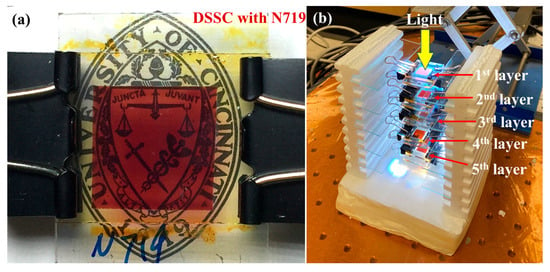
Figure 14.
(a) Photograph of a single DSSC with N719 over the logo of University of Cincinnati and (b) 3D-Solar system with five N719-DSSCs in parallel [47,48].

Table 4.
I-V curve parameters of DSSCs arranged in parallel, as shown in Figure 14b [47].
1.17. Design of 3D-Solar System Design for Agrivoltaics
The design of the 3D-Solar system faces two key challenges. First, the current DSSCs suffer from low power conversion efficiency (PCE), limiting their capacity to effectively harness solar energy. Second, although transparent DSSCs have been developed for the multiple PV panel systems [47], much greater AVT will be required. Figure 1b illustrates the concept of a 3D-Solar system, where multiple transparent DSSCs or organic photovoltaics (OPV) are arranged in parallel and separated by spacers. This design enables precise measurement of light power density at each layer and facilitates the assessment of light power attenuation based on the number of PV panels. Preliminary data from refs. [29,31,47,48] suggest that optimal AVT and PCE can be achieved by multiple transparent PVs [29,47,48] and carefully tuning hybrid compositions [31]. In a 3D-Solar system with DSSCs, transparency can be enhanced with the grid patterns, as shown in Figure 13c. This strategy allows fine-tuning light transmission, ensuring an optimized distribution of light power density across each PV panel while maintaining efficient energy generation.
1.18. System Design of 3D-Solar for Agrivoltaics
The design of 3D-Solar systems involves several key parameters, including system dimensions, light incident angles, and PV panel height, all of which influence overall efficiency. Collaborations between materials scientists, PV technology engineers, agricultural researchers, and industry stakeholders are critical for the successful implementation of the 3D-Solar system (Figure 15). The balance between energy generation and crop productivity must be balanced in the integration of transparent photovoltaics (PVs) with agriculture. The PV panels in the 3D-Solar systems need to be elevated to optimize both solar harvesting and light transmission to crops (Figure 2). In the design of a 3D-Solar system, both plant responses and photovoltaic performance must be evaluated to ensure an optimal balance between agricultural yield and energy production. Furthermore, the transmitted light from the PV panels must be characterized according to PAR, as shown in Figure 8. Other factors include the number of transparent PV panels, their average visible transmittance (AVT), and spectral selectivity enabled by the hybrid photosensitizer.
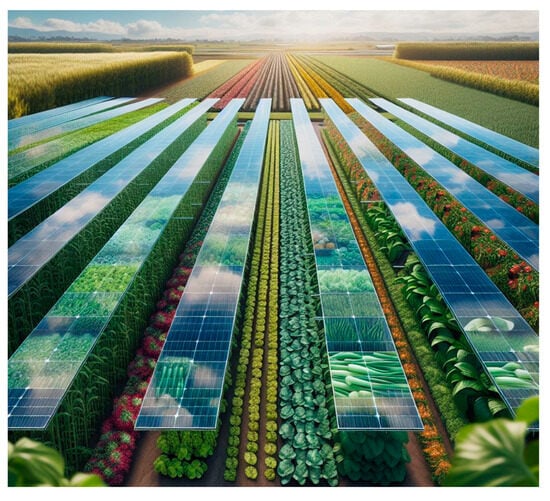
Figure 15.
Schematic diagram showing the transparent PVs in the 3D-Solar system for agrivoltaics.
The integration of spectrally selective 3D-Solar in agrivoltaics systems balances complex interactions between light transmission, thermal regulation, and water dynamics, collectively influencing crop yield. Although the PVs in the 3D-Solar system are highly transparent, its shading effect can reduce excessive solar irradiation, thereby lowering leaf temperature and mitigating heat stress. This shading effect can also be tuned by a number of PV panels and the overall AVT of the 3D-Solar system, which is particularly beneficial in regions with high solar intensity. Furthermore, the cooling effect resulting from reduced transpiration can enhance water use efficiency by decreasing evapotranspiration rates.
Spectral selective light modulation can further enhance the 3D-Solar system by transmitting and tuning red and blue light for effective photosynthesis of both C3 and C4 plants. The spectral selective PV panels can absorb excessive near-infrared radiation that contributes to heat stress. Therefore, the optimized 3D-Solar system exhibits the light–heat–water coupling effect for improved crop growth conditions by balancing energy generation with microclimatic benefits. Future experimental studies and modeling efforts will be essential to quantitatively assess the impact of these interactions on crop yield and water conservation, further advancing the feasibility of agrivoltaics systems.
It should be noted that this review provides more experimental details on DSSC in agrivoltaics as one of the possible PV panels for its high transparency and unique solar harvesting in the IR region. Other transparent PVs, such as OPV and CdTe, can also be considered for 3D-Solar system applications. CdTe has been applied in energy-neutral building skins due to its high AVT (80%) and appreciable PCE. OPVs are desirable due to their light weight and flexibility. Although silicon-based PVs are non-transparent, the patterned grids can be a possibility in the 3D-Solar system, as shown in Figure 13. With the narrow strips of Si-PV separated by equal-sized transparent substrates, the patterned grids can allow light to partially pass through them to enhance crop growth while generating electric power at the same time.
The key performance parameters of major PV technologies are compared and summarized in Table 5, including the average visible transparency (AVT), power conversion efficiency (PCE), stability, cost, and agricultural adaptability. In particular, Table 5 highlights the key differences between these PV technologies, such as dye-sensitized solar cells (DSSCs), perovskite photovoltaics, organic photovoltaics (OPVs), and CdTe. It is important to note that key performance parameters in Table 5 are only in the averaged ranges, yet they offer insights into their advantages and limitations for agrivoltaic applications. It should also be noted that porphyrin hybrids can be applied in both perovskite and DSSC PVs. They offer greater flexibility in tuning transparency and efficiency trade-offs. While porphyrin-functionalized perovskites can improve stability and carrier mobility, leading to higher efficiency and durability, zinc porphyrin-based DSSCs have achieved over 13% power conversion efficiency (PCE). OPVs provide a balance of moderate efficiency, high transparency, and excellent flexibility, making them highly adaptable for agricultural integration. CdTe panels present a high-AVT and appreciable PCE alternative with proven stability, but their toxicity has presented some concerns in agriculture applications.

Table 5.
Key performance parameters of different PV technologies.
1.19. Challenges and Future Research
The idea of 3D-Solar agrivoltaics is still a new development that faces several critical challenges that must be addressed in order to achieve optimal performance and practical implementation. Not only do these challenges span fundamental scientific questions related to material design, photonic behavior, and system integration, but also engineering system designs in the area of structural integrity, system architecture, power generation, and balanced crop yield. In materials science, unique PV materials must be designed and developed with tunable spectral selectivity in the UV and IR regions for high AVT and improved overall system PCE. These properties will ensure significant solar harvesting and power generation that is comparable to the current commercial PV systems. On the other hand, in agrivoltaics, one of the major purposes is to increase crop yield via enhanced photosynthesis. This will require 3D-Solar to provide substantial sunlight within the wavelength between 400 nm and 700 nm. Therefore, transparent PVs must selectively harvest sunlight spectrally in the designated regions to serve both purposes of photovoltaic electric power generation and photosynthesis with an optimum balance. However, none of the current PV solar cells ideally satisfy these requirements. Therefore, searching for and developing advanced novel PV materials with required optical properties will be the primary task in agrivoltaics applications. Future research will require a multidisciplinary approach that integrates advanced materials synthesis and characterization, device engineering, and 3D-Solar system design. Research efforts will focus on optimizing material properties, especially in terms of spectral selectivity, transparency, and power conversion efficiency. Collaborations between solar technology and agricultural researchers will be critical in jointly developing a viable 3D-Solar system in agrivoltaics.
2. Summary
This review has identified several critical issues in agrivoltaics, including solar harvesting, power generation, and crop yield. One critical issue arises from the silicon-based PV panels blocking a substantial portion of sunlight, reducing photosynthesis and impacting crop yields. While organic photovoltaics (OPVs) offer some advantages, such as light weight and low cost, their spectral selectivity and power conversion efficiency must be significantly improved. This review introduced some current research in developing highly transparent PVs for 3D-Solar system design. CdTe is desirable for multiple PV panel systems in terms of its high AVT (up to 80%) and appreciable PCE (18%). The previous experimental results demonstrate the possibility of 3D solar harvesting via a stack of transparent CdTe PVs with significantly enhanced system PCE [29]. By stacking five semitransparent CdTe PV in parallel, the system PCE reaches a substantial 233% improvement. By transforming solar harvesting from 2D to 3D, the PCEs of other semitransparent PVs, such as OPV, can also be systematically enhanced.
This review also addressed the fundamental materials science challenges in spectral selectivity and PV transparency via novel designs of porphyrin hybrids. A bio-inspired solution with green porphyrins has been shown to offer a promising pathway for spectral and transparency tuning. In particular, novel porphyrin hybrids exhibit strong absorption in the UV and IR regions while allowing the most visible light to pass through, making them ideal candidates for the 3D-Solar system in agrivoltaics. Spectral tunability can be achieved and optimized by controlling the ratio of various components with unique optical characteristics. The feasibility of the 3D-Solar system is supported by previously published data, which demonstrate the potential for enhanced solar harvesting and controlled light transmission. By partitioning sunlight for two aspects of agrivoltaics, namely, UV/IR for power generation and PAR for crop photosynthesis, this novel approach will enable sustainable agrivoltaic practices such as plant growth and improve soil moisture retention. Spectrally and transparency-tunable PVs provide a comprehensive strategy for balancing between photosynthesis and PV power generation. The insights presented herein lay the foundation for future advancements in transparent PV design, photonic tuning, and sustainable energy integration, ensuring a systematic path toward optimized agrivoltaic performance.
Funding
This research was funded by the National Science Foundation CMMI-1953009 and the Michelman Green, Clean and Sustainable Technology Research Innovation Program (F103484).
Data Availability Statement
Data are available in a publicly accessible repository.
Conflicts of Interest
The author declares no conflict of interest.
References
- Nayak, P.K.; Mahesh, S.; Snaith, H.J.; Cahen, D. Photovoltaic solar cell technologies: Analysing the state of the art. Nat. Rev. Mater. 2019, 4, 269–285. [Google Scholar] [CrossRef]
- He, Z.; Zhong, C.; Su, S.; Xu, M.; Wu, H.; Cao, Y. Enhanced power-conversion efficiency in polymer solar cells using an inverted device structure. Nat. Photonics 2012, 6, 591–595. [Google Scholar] [CrossRef]
- You, J.; Dou, L.; Yoshimura, K.; Kato, T.; Ohya, K.; Moriarty, T.; Emery, K.; Chen, C.-C.; Gao, J.; Li, G.; et al. A polymer tandem solar cell with 10.6% power conversion efficiency. Nat. Commun. 2013, 4, 1446. [Google Scholar] [CrossRef] [PubMed]
- Andreani, L.C.; Bozzola, A.; Kowalczewski, P.; Liscidini, M.; Redorici, L. Silicon solar cells: Toward the efficiency limits. Adv. Phys. X 2018, 4, 1548305. [Google Scholar] [CrossRef]
- Tonui, P.; Oseni, S.O.; Sharma, G.; Yan, Q.; Mola, G.T. Perovskites photovoltaic solar cells: An overview of current status. Renew. Sustain. Energy Rev. 2018, 91, 1025–1044. [Google Scholar] [CrossRef]
- Available online: https://elements.visualcapitalist.com/how-much-land-power-us-solar/ (accessed on 11 August 2019).
- Al-Ezzi, A.S.; Ansari, M.N.M. Photovoltaic Solar Cells: A Review. Appl. Syst. Innov. 2022, 5, 67. [Google Scholar] [CrossRef]
- Jäger-Waldau, A.; Szabó, M.; Monforti-Ferrario, F.; Bloem, H.; Huld, T.; Arantegui, R.L. Renewable energy snapshots 2011. Available online: https://www.jrc.ec.europa.eu/ (accessed on 11 October 2022).
- Yamaguchi, M.; Yamada, H.; Katsumata, Y.; Lee, K.H.; Araki, K.; Kojima, N. Efficiency potential and recent activities of high-efficiency solar cells. J. Mater. Res. 2017, 32, 3445–3457. [Google Scholar] [CrossRef]
- Masuko, K.; Shigematsu, M.; Hashiguchi, T.; Fujishima, D.; Kai, M.; Yoshimura, N.; Yamaguchi, T.; Ichihashi, Y.; Mishima, T.; Matsybara, N.; et al. Achievement of more than 25% conversion efficiency with crystalline silicon heterojunction solar cell. IEEE J. Photovolt. 2014, 4, 1433–1435. [Google Scholar] [CrossRef]
- Firdaus, Y.; Le Corre, V.M.; Khan, J.I.; Kan, Z.; Laquai, F.; Beaujuge, P.M.; Anthopoulos, T.D. Key Parameters Requirements for Non-Fullerene-Based Organic Solar Cells with Power Conversion Efficiency >20%. Adv. Sci. 2019, 6, 1802028. [Google Scholar] [CrossRef]
- Cui, Y.; Yao, H.; Hong, L.; Zhang, T.; Tang, Y.; Lin, B.; Xian, K.; Gao, B.; An, C.; Bi, P.; et al. Organic photovoltaic cell with 17% efficiency and superior processability. Natl. Sci. Rev. 2019, 7, 1239–1246. [Google Scholar] [CrossRef]
- Ryuzaki, S.; Onoe, J. Basic aspects for improving the energy conversion efficiency of hetero-junction organic photovoltaic cells. Nano Rev. 2013, 4, 29055. [Google Scholar] [CrossRef]
- Cui, Y.; Yao, H.; Zhang, J.; Xian, K.; Zhang, T.; Hong, L.; Wang, Y.; Xu, Y.; Ma, K.; An, C.; et al. Single-Junction Organic Photovoltaic Cells with Approaching 18% Efficiency. Adv. Mater. 2020, 32, 1908205. [Google Scholar] [CrossRef]
- Bolinger, M.; Bolinger, G. Land Requirements for Utility-Scale PV: An Empirical Update on Power and Energy Density. IEEE J. Photovolt. 2022, 12, 589–594. [Google Scholar] [CrossRef]
- Nazir, G.; Lee, S.Y.; Lee, J.H.; Rehman, A.; Lee, J.K.; Seok, S.I.; Park, S.J. Stabilization of Perovskite Solar Cells: Recent Developments and Future Perspectives. Adv. Mater. 2022, 34, 2204380. [Google Scholar]
- Lekesi, L.P.; Koao, L.F.; Motloung, S.V.; Motaung, T.E.; Malevu, T. Developments on Perovskite Solar Cells (PSCs): A Critical Review. Appl. Sci. 2022, 12, 672. [Google Scholar] [CrossRef]
- Hu, Z.; Ran, C.; Zhang, H.; Chao, L.; Chen, Y.; Huang, W. The Current Status and Development Trend of Perovskite Solar Cells. Engineering 2022, 21, 15–19. [Google Scholar] [CrossRef]
- Fu, Q.; Jen, A.K. Perovskite solar cell developments, whatʼs next? Next Energy 2023, 1, 100004. [Google Scholar] [CrossRef]
- Rahman, S.; Haleem, A.; Siddiq, M.; Hussain, M.K.; Qamar, S.; Hameed, S.; Waris, M. Research on dye sensitized solar cells: Recent advancement toward the various constituents of dye sensitized solar cells for efficiency enhancement and future prospects. RSC Adv. 2023, 13, 19508–19529. [Google Scholar]
- Prajapat, K.; Dhonde, M.; Sahu, K.; Bhojane, P.; Murty, V.; Shirage, P.M. The evolution of organic materials for efficient dye-sensitized solar cells. J. Photochem. Photobiol. C Photochem. Rev. 2023, 55, 100586. [Google Scholar] [CrossRef]
- Sasikumar, R.; Thirumalaisamy, S.; Kim, B.; Hwang, B. Dye-sensitized solar cells: Insights and research divergence towards alternatives. Renew. Sustain. Energy Rev. 2024, 199, 114549. [Google Scholar] [CrossRef]
- Miao, J.; Wang, Y.; Liu, J.; Wang, L. Organoboron molecules and polymers for organic solar cell applications. Chem. Soc. Rev. 2022, 51, 153–187. [Google Scholar] [CrossRef] [PubMed]
- Wang, J.; Cui, Y.; Xu, Y.; Xian, K.; Bi, P.; Chen, Z.; Zhou, K.; Ma, L.; Zhang, T.; Yang, Y.; et al. A New Polymer Donor Enables Binary All-Polymer Organic Photovoltaic Cells with 18% Efficiency and Excellent Mechanical Robustness. Adv. Mater. 2022, 34, 2205009. [Google Scholar] [CrossRef] [PubMed]
- Yuan, X.; Zhao, Y.; Xie, D.; Pan, L.; Liu, X.; Duan, C.; Huang, F.; Cao, Y. Polythiophenes for organic solar cells with efficiency surpassing 17%. Joule 2022, 6, 647–661. [Google Scholar] [CrossRef]
- Brudermann, T.; Reinsberger, K.; Orthofer, A.; Kislinger, M.; Posch, A. Photovoltaics in agriculture: A case study on decision making of farmers. Energy Policy 2013, 61, 96–103. [Google Scholar] [CrossRef]
- Muñoz-García, M.A.; Hernández-Callejo, L. Photovoltaics and Electrification in Agriculture. Agronomy 2022, 12, 44. [Google Scholar] [CrossRef]
- Meitzner, R.; Schubert, U.S.; Hoppe, H. Agrivoltaics—The Perfect Fit for the Future of Organic Photovoltaics. Adv. Energy Mater. 2020, 11, 2002551. [Google Scholar] [CrossRef]
- Katepalli, A.; Wang, Y.; Shi, D. Solar harvesting through multiple semi-transparent cadmium telluride solar panels for collective energy generation. Sol. Energy 2023, 264, 112047. [Google Scholar] [CrossRef]
- Liu, J.; van Iersel, M.W. Photosynthetic Physiology of Blue, Green, and Red Light: Light Intensity Effects and Underlying Mechanisms. Front. Plant Sci. 2021, 12, 619987. [Google Scholar] [CrossRef]
- Lin, J.; Wang, Y.; Lyu, M.; Deng, Z.; Shi, D. Transparent porphyrin-based hybrid films for spectral selective solar harvesting and energy generation. Sol. Energy Mater. Sol. Cells 2022, 243, 15. [Google Scholar]
- D’souza, F.; Ito, O. Supramolecular donor–acceptor hybrids of porphyrins/phthalocyanines with fullerenes/carbon nanotubes: Electron transfer, sensing, switching, and catalytic applications. Chem. Commun. 2009, 33, 4913–4928. [Google Scholar] [CrossRef]
- Gust, D.; Moore, T.A.; Moore, A.L. Solar fuels via artificial photosynthesis. Accounts Chem. Res. 2009, 42, 1890–1898. [Google Scholar] [CrossRef]
- Imahori, H.; Fukuzumi, S. Porphyrin-and fullerene-based molecular photovoltaic devices. Adv. Funct. Mater. 2004, 14, 525–536. [Google Scholar] [CrossRef]
- Shipman, L.L.; Cotton, T.M.; Norris, J.R.; Katz, J.J. An analysis of the visible absorption spectrum of chlorophyll a monomer, dimer, and oligomers in solution. J. Am. Chem. Soc. 1976, 98, 8222–8230. [Google Scholar] [CrossRef]
- Li, X.; Tang, C.; Zhang, L.; Song, M.; Zhang, Y.; Wang, S. Porphyrin-Based Covalent Organic Frameworks: Design, Synthesis, Photoelectric Conversion Mechanism, and Applications. Biomimetics 2023, 8, 171. [Google Scholar] [CrossRef]
- Chang, S.Y.; Cheng, P.; Li, G.; Yang, Y. Transparent polymer photovoltaics for solar energy harvesting and beyond. Joule 2018, 2, 1039–1054. [Google Scholar] [CrossRef]
- Chen, C.C.; Dou, L.; Zhu, R.; Chung, C.H.; Song, T.B.; Zheng, Y.B.; Hawks, S.; Li, G.; Weiss, P.S.; Yang, Y. Visibly transparent polymer solar cells produced by solution processing. ACS Nano 2012, 6, 7185–7190. [Google Scholar] [CrossRef]
- Yu, H.; Wang, J.; Zhou, Q.; Qin, J.; Wang, Y.; Lu, X.; Cheng, P. Semi-transparent organic photovoltaics. Chem. Soc. Rev. 2023, 52, 4132–4148. [Google Scholar] [CrossRef]
- Song, W.; Ge, J.; Xie, L.; Chen, Z.; Ye, Q.; Sun, D.; Shi, J.; Tong, X.; Zhang, X.; Ge, Z. Semi-transparent organic photovoltaics for agrivoltaic applications. Nano Energy 2023, 116, 108805. [Google Scholar] [CrossRef]
- Emmott, C.J.; Röhr, J.A.; Campoy-Quiles, M.; Kirchartz, T.; Urbina, A.; Ekins-Daukes, N.J.; Nelson, J. Organic photovoltaic greenhouses: A unique application for semi-transparent PV? Energy Environ. Sci. 2015, 8, 1317–1328. [Google Scholar] [CrossRef]
- Liu, T.; Zheng, Y.; Xu, Y.; Liu, X.; Wang, C.; Yu, L.; Fahlman, M.; Li, X.; Murto, P.; Chen, J.; et al. Semitransparent polymer solar cell/triboelectric nanogenerator hybrid systems: Synergistic solar and raindrop energy conversion for window-integrated applications. Nano Energy 2022, 103, 107776. [Google Scholar] [CrossRef]
- Sun, S.; Zha, W.; Tian, C.; Wei, Z.; Luo, Q.; Ma, C.; Liu, W.; Zhu, X. Solution Processed Semi-Transparent Organic Solar Cells Over 50% Visible Transmittance Enabled by Silver Nanowire Electrode with Sandwich Structure. Adv. Mat. 2023, 35, 2305092. [Google Scholar] [CrossRef]
- Zhao, Y.; Zhu, Y.; Cheng, H.-W.; Zheng, R.; Meng, D.; Yang, Y. A review on semitransparent solar cells for agricultural application. Mater. Today Energy 2021, 22, 100852. [Google Scholar] [CrossRef]
- Gorjian, S.; Bousi, E.; Özdemir, Ö.E.; Trommsdorff, M.; Kumar, N.M.; Anand, A.; Kant, K.; Chopra, S.S. Progress and challenges of crop production and electricity generation in agrivoltaic systems using semi-transparent photovoltaic technology. Renew. Sustain. Energy Rev. 2022, 158, 112126. [Google Scholar] [CrossRef]
- Setyawati, H.; Darmokoesoemo, H.; Ningtyas, A.T.A.; Kadmi, Y.; Elmsellem, H.; Kusuma, H.S. Effect of Metal Ion Fe(III) on the Performance of Chlorophyll as Photosensitizers on Dye Sensitized Solar Cell. Results Phys. 2017, 7, 2907–2918. [Google Scholar]
- Lin, J.; Krupczak, J.; Shi, D. Solar harvesting and energy generating building skins with photothermal–photovoltaic dual-modality based on porphyrin thin films. MRS Commun. 2022, 12, 1225–1234. [Google Scholar] [CrossRef]
- Lin, J.; Lyu, M.; Shi, D. 3D Solar Harvesting and Energy Generation via Multilayers of Transparent Porphyrin and Iron Oxide Thin Films. Energies 2023, 16, 3173. [Google Scholar] [CrossRef]
- Lyu, M.; Lin, J.; Krupczak, J.; Shi, D. Solar harvesting through multilayer spectral selective iron oxide and porphyrin transparent thin films for photothermal energy generation. Adv. Sustain. Syst. 2021, 5, 2100006. [Google Scholar] [CrossRef]
- Lin, J.; Shi, D. Photothermal and photovoltaic properties of transparent thin films of porphyrin compounds for energy applications. Appl. Phys. Rev. 2021, 8, 011302. [Google Scholar]
- Zhao, Y.; Dunn, A.W.; Shi, D. Effective reduction of building heat loss without insulation materials via the photothermal effect of a chlorophyll thin film coated “Green Window”. MRS Commun. 2019, 9, 675–681. [Google Scholar] [CrossRef]
- Zhao, Y.; Lin, J.; Kundrat, D.M.; Bonmarin, M.; Krupczak, J.; Thomas, S.V.; Lyu, M.; Shi, D. Photonically-Activated Molecular Excitations for Thermal Energy Conversion in Porphyrinic Compounds. Phys. Chem. C 2019, 124, 1575–1584. [Google Scholar] [CrossRef]
- Lyu, M.; Lin, J.; Krupczak, J., Jr.; Shi, D. Light angle dependence of photothermal properties in oxide and porphyrin thin films for energy-efficient window applications. MRS Commun. 2020, 10, 439–448. [Google Scholar] [CrossRef]
- Grätzel, M. Dye-Sensitized Solar Cells. J. Photochem. Photobiol. C Photochem. Rev. 2003, 4, 145–153. [Google Scholar] [CrossRef]
- Wu, C.; Chen, J.; Liu, Y.; Hou, J. Dye-sensitized solar cells: Recent advances and challenges. J. Mater. Chem. A 2016, 4, 7548–7564. [Google Scholar]
- Wang, X.; Grätzel, M. Dye-sensitized solar cells: From basics to the state of the art. Energy Environ. Sci. 2013, 6, 242–269. [Google Scholar]
- O’Regan, S.; Grätzel, M. A low-cost, high-efficiency solar cell based on dye-sensitized colloidal TiO2 films. Nature 1991, 353, 737–740. [Google Scholar] [CrossRef]
- Kim, J.; Lee, Y.; Kim, H. Dye-Sensitized Solar Cells: A Review on Materials, Devices, and Applications. Adv. Mater. 2010, 22, 1834–1850. [Google Scholar]
- Prince, R.; Grunwaldt, J. Dye-sensitized solar cells: Materials, devices, and future perspectives. Chem. Soc. Rev. 2015, 44, 123–142. [Google Scholar]
- De Angelis, F.; Di Carlo, A.; Filippetti, A.; Fontanesi, C. Porphyrin-Based Dye-Sensitized Solar Cells: A First-Principles Study. J. Phys. Chem. C 2007, 111, 11558–11564. [Google Scholar]
- Birel, Ö.; Nadeem, S.; Duman, H. Porphyrin-Based Dye-Sensitized Solar Cells (DSSCs): A Review. J. Fluoresc. 2017, 27, 1075–1085. [Google Scholar] [CrossRef]
- Yella, A.; Lee, H.W.; Tsao, H.N.; Yi, C.; Chandiran, A.K.; Nazeeruddin, M.K.; Diau, E.W.G.; Yeh, C.Y.; Zakeeruddin, S.M.; Grätzel, M. Porphyrin-sensitized solar cells with cobalt (II/III)-based redox electrolyte exceed 12 percent efficiency. Science 2011, 334, 629–634. [Google Scholar] [CrossRef]
- Hupp, J.T.; Niemczyk, M.P. Porphyrins as materials platforms for molecular solar cells. J. Mater. Chem. A 2013, 1, 12773–12783. [Google Scholar]
- Mathew, S.; Yella, A.; Gao, P.; Humphry-Baker, R.; Curchod, B.F.E.; Ashari-Astani, N.; Tavernelli, I.; Rothlisberger, U.; Nazeeruddin, K.; Grätzel, M. Dye-sensitized solar cells with 13% efficiency achieved through the molecular engineering of porphyrin sensitizers. Nat. Chem. 2014, 6, 242–247. [Google Scholar] [PubMed]
- Li, L.L.; Diau, E.W.G. Porphyrin-sensitized solar cells. Chem. Soc. Rev. 2013, 42, 291–304. [Google Scholar] [CrossRef] [PubMed]
- Wu, H.; Mayer, M.T.; Yang, J. Efficient dye-sensitized solar cells using an organic redox couple. J. Am. Chem. Soc. 2009, 131, 15617–15624. [Google Scholar]
- Kay, A.; Graetzel, M. Artificial photosynthesis. 1. photosensitization of titania solar cells with chlorophyll derivatives and related natural porphyrins. J. Phys. Chem. 1993, 97, 6272–6277. [Google Scholar]
- Sanusi, K.; Atewolara-Odule, O.C.; Sanyaolu, N.O.; Ibikunle, A.A.; Khoza, P.B.; Fatomi, N.O.; Fasanya, S.A.; Abuka, H.E.; Jesugbile, E.O.; Yilmaz, Y.; et al. Effects of solvents and substituents on the adsorptive and photovoltaic properties of porphyrins for dye-sensitized solar cell application: A theoretical consideration. Struct. Chem. 2023, 34, 891–904. [Google Scholar] [CrossRef]
- Dos Santos, T.; Morandeira, A.; Koops, S.; Mozer, A.J.; Tsekouras, G.; Dong, Y.; Wagner, P.; Wallace, G.; Earles, J.C.; Gordon, K.C.; et al. Injection limitations in a series of porphyrin dye-sensitized solar cells. J. Phys. Chem. C 2010, 114, 3276–3279. [Google Scholar]
- Bessho, T.; Zakeeruddin, S.M.; Yeh, C.; Diau, E.W.; Grätzel, M. Highly efficient mesoscopic dye-sensitized solar cells based on donor-acceptor-substituted porphyrins. Angew. Chem. Int. Ed. 2010, 49, 6646–6649. [Google Scholar] [CrossRef]
- Singh, J. (Ed.) Optical Properties of Condensed Matter and Applications; John Wiley & Sons: Hoboken, NJ, USA, 2006; Volume 6. [Google Scholar]
- Najm, A.S.; Alwash, S.A.; Sulaiman, N.H.; Chowdhury, M.S.; TechatoKim, K.; Kim, T.H.; Kim, C.H. N719 dye as a sensitizer for dye-sensitized solar cells (DSSCs): A review of its functions and certain rudimentary principles. Environ. Prog. Sustain. Energy 2022. [Google Scholar] [CrossRef]
- Sharma, G.; Dawo, C.; Mulchandani, K.; Kumawat, U.K.; Singhal, R.; Lal, C. Revealing the photophysics of N719 dye based dye-sensitized solar cell. Opt. Mater. 2023, 142, 114113. [Google Scholar] [CrossRef]
- Wu, Y.; Liu, J.-C.; Li, R.-Z.; Ci, C.-G. Different metal upper porphyrin based self-assembly sensitizers for application in efficient dye-sensitized solar cells. Polyhedron 2022, 211, 115573. [Google Scholar] [CrossRef]
- Mehboob, S.; AlMasoud, N.; Alomar, T.S.; Bhatti, M.H.; Khan, J.; Asif, H.M.; Khan, M.A.; El-Bahy, Z.M. Synthesis of donor-acceptor type 2D porphyrin based cyclic imides as an efficient photo catalysts in DSSC solar cell. Opt. Mater. 2024, 150, 115291. [Google Scholar] [CrossRef]
- Roy, P.; Ghosh, A.; Barclay, F.; Khare, A.; Cuce, E. Perovskite Solar Cells: A Review of the Recent Advances, Priyanka Roy, Aritra Ghosh, Fraser Barclay, Ayush Khare and Erdem Cuce. Coatings 2022, 12, 1089. [Google Scholar] [CrossRef]
- Basumatary, P.; Agarwal, P. A short review on progress in perovskite solar cells. Mater. Res. Bull. 2022, 149, 111700. [Google Scholar] [CrossRef]
- Allam, Z.; Boudaoud, C.; Bouchachia, B.; Soufi, A. Simulation of CdTe/CdS heterostructure with graphene contact. Mater. Today Proc. 2022, 51, 2152–2156. [Google Scholar] [CrossRef]
- Preet, S.; Smith, S.T. A comprehensive review on the recycling technology of silicon based photovoltaic solar panels: Challenges and future outlook. J. Clean. Prod. 2024, 448, 141661. [Google Scholar] [CrossRef]
- Okil, M.; Salem, M.S.; Abdolkader, T.M.; Shaker, A. From Crystalline to Low-cost Silicon-based Solar Cells: A Review. Silicon 2021, 14, 1895–1911. [Google Scholar] [CrossRef]
Disclaimer/Publisher’s Note: The statements, opinions and data contained in all publications are solely those of the individual author(s) and contributor(s) and not of MDPI and/or the editor(s). MDPI and/or the editor(s) disclaim responsibility for any injury to people or property resulting from any ideas, methods, instructions or products referred to in the content. |
© 2025 by the author. Licensee MDPI, Basel, Switzerland. This article is an open access article distributed under the terms and conditions of the Creative Commons Attribution (CC BY) license (https://creativecommons.org/licenses/by/4.0/).